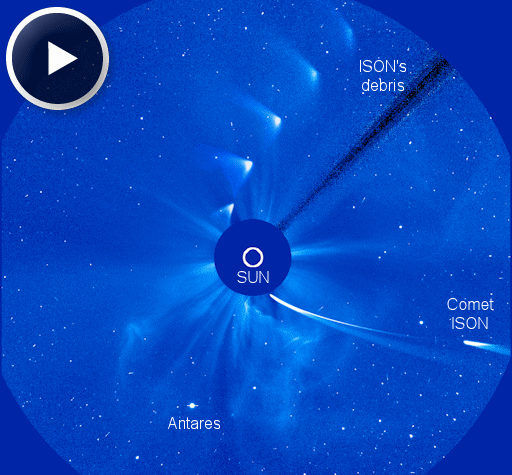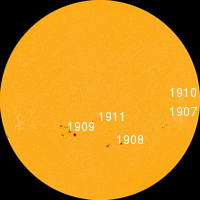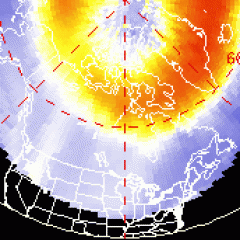~ Space Weather Update~COMET ISON, R.I.P. [1]
CHANCE OF STORMS: NOAA forecasters estimate a 25% chance of polar geomagnetic storms on Dec. 2nd when a CME might deliver a glancing blow to Earth's magnetic field. High-latitude sky watchers should be alert for auroras. Aurora alerts: text [2], voice [3]
COMET ISON, R.I.P.: Following its Thanksgiving Day brush with solar fire, sundiving Comet ISON is now just a cloud of dust. Among experts, a consensus is building that the comet broke apart shortly before perihelion (closest approach to the sun). In the movie [4], note how rapidly the comet fades just before it vanishes behind the occulting disk of the SOHO coronagraph [5]:
After perihelion, the comet emerges as a diffuse remnant of its former self. No one knows for sure what is inside that fan-shaped cloud. Possibilities include a small remnant nucleus or a "rubble pile" of furiously vaporizing fragments. By the end of the day on Nov. 28th, Comet ISON was spent.
As of Dec. 2nd, the cloud of debris is no brighter than a star of approximately 8th magnitude. Experienced astrophotographers might be able to capture the comet's fading "ghost" in the pre-dawn sky of early December, but a naked-eye spectacle is out of the question.
Realtime Comet ISON Photo Gallery [6]
CHINA LAUNCHES LUNAR ROVER: Move over USA and Russia, China is about to join the club of nations that have landed on the Moon. On Dec. 1st, China's Chang'e-3 spacecraft blasted off from the Sichuan province in southwest China. It's payload: a six-wheeled, 260-lb rover named the "Jade Rabbit" ("Yutu" in Chinese), which could touch down on the lunar surface as early as Dec. 14th.
 [7]
[7]
An artist's concept of the Jade Rabbit rolling out onto the lunar surface.
Unlike the soft landings of unmanned spacecraft from the USA and the Soviet Union, Chang'e-3 will be able to survey the landscape first and determine the safest spot. The most likely destination is Sinus Iridum, the Bay of Rainbows.
A Chinese-made nuclear battery will power the rover after it lands on the lunar surface. Using plutonium-238, the battery will last for more than 30 years. The rover also has expandable solar arrays to absorb the sun’s energy during the day and retract at night to cover and protect equipment from temperatures of minus 170 degrees Celsius. Onboard sensors include a ground-probing radar, cameras, and a soil sampler.
Jade Rabbit's name comes a Chinese myth: According to the ancient story, a lady called Chang'e swallowed magic pills, which allowed her to fly to the Moon along with her pet rabbit "Yutu". There she became a goddess, and has been living on the Moon with the white rabbit ever since.
Congratulations to the people of China for their successful launch and lunar ambitions.

Solar wind
speed: 403.0 km/sec
density: 1.4 protons/cm3
explanation [8] | more data [9]
Updated: Today at 0007 UT
X-ray Solar Flares
6-hr max: B6 1834 UT Dec02
24-hr: C2 1444 UT Dec02
explanation [10] | more data [11]
Updated: Today at: 2359 UT
![]()
Daily Sun: 02 Dec 13
Sunspots AR1908 and AR1909 have 'beta-gamma' magnetic fields that harbor energy for M-class [5] solar flares. Credit: SDO/HMI
![]()
Sunspot number: 104
What is the sunspot number? [13]
Updated 02 Dec 2013
Spotless Days
Current Stretch: 0 days
2013 total: 0 days (0%)
2012 total: 0 days (0%)
2011 total: 2 days (<1%)
2010 total: 51 days (14%)
2009 total: 260 days (71%)
Since 2004: 821 days
Typical Solar Min: 486 days
Update 02 Dec 2013
The Radio Sun
10.7 cm flux: 131 sfu
explanation [14] | more data [15]
Updated 02 Dec 2013
![]()
Current Auroral Oval:
Switch to: Europe, USA, New Zealand, Antarctica
Credit: NOAA/POES
![]()
Planetary K-index
Now: Kp= 0 quiet
24-hr max: Kp= 0 quiet
explanation [17] | more data [18]
Interplanetary Mag. Field
Btotal: 6.9 nT
Bz: 2.4 nT south
explanation [19] | more data [20]
Updated: Today at 0007 UT
![]()
Coronal Holes: 02 Dec 13
A stream of solar wind flowing from the indicated coronal hole should reach Earth on or about Dec. 7th. Credit: SDO/AIA.



